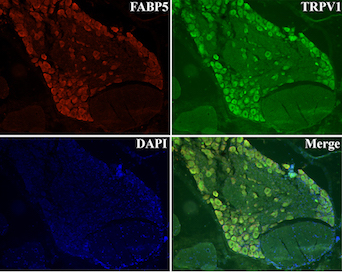|
 |
TRPV1 is an ion channel that mediates inflammatory pain. FABP5 co-localizes with TRPV1 in dorsal root ganglia and its inhibition reduces inflammatory pain. Our current efforts are focused upon characterizing the interplay between FABPs and TRPV1 within the context of pain. |
Lipid Metabolism and Signaling: Roles in Pain and Inflammation
There are several major areas of research in the Kaczocha lab.
- Role of FABPs in inflammatory pain: Our group has previously demonstrated that FABP inhibition produces analgesia in rodents. In collaboration with colleagues in the Departments of Chemistry, Biochemistry and Cell Biology, and Applied Mathematics and Statistics, we are currently developing FABP inhibitors for the treatment of pain and inflammatory disorders. Furthermore, our laboratory is currently investigating the cellular mechanisms that underlie analgesia resulting from FABP inhibition.
- Endocannabinoid metabolism and postsurgical pain: Endocannabinoids are considered analgesic lipids. However, endocannabinoid metabolism produces lipid metabolites that contribute to pain. Using established and novel preclinical models of postoperative pain and patient derived tissue samples, we are currently investigating whether inhibition of endocannabinoid metabolizing enzymes produces analgesia.
- Modulation of brain endocannabinoid signaling by FABPs: Endocannabinoids are neuromodulatory lipids that are released by postsynaptic neurons and activate cannabinoid receptors on presynaptic axon terminals. In collaboration with colleagues at the University at Buffalo, our laboratory has recently uncovered a novel role for FABPs in brain endocannabinoid signaling. Our current efforts are focused upon developing novel genetic tools and transgenic mouse models to dissect the contribution of FABPs toward brain endocannabinoid signaling and their effects upon behavior.
- FABPs and cancer: FABPs are upregulated in aggressive cancers and are associated with poorer outcomes. Our laboratory is investigating the mechanisms by which FABPs promote cancer cell aggressiveness with a particular focus on lipid signaling networks.
- Control of phytocannabinoid signaling by FABPs: Our group has recently demonstrated that Δ9-tetrahydrocannabinol and cannabidiol, the two major phytocannabinoids in marijuana, interact with FABPs. Our current work is focused upon unraveling how FABPs regulate phytocannabinoid metabolism and signaling.

